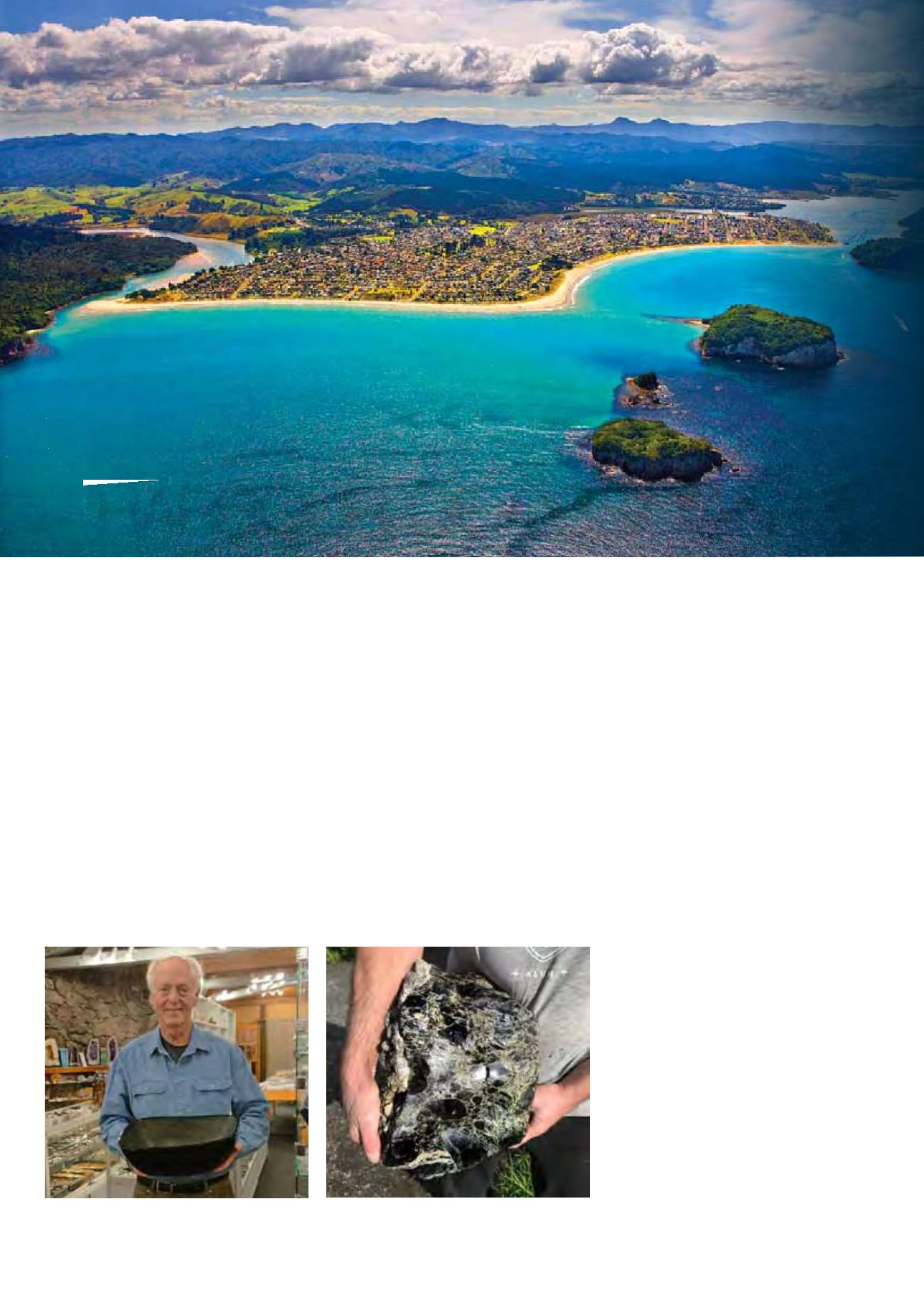

by Robert Simmons
We asked our rockhound Robert Simmons
from Heaven and Earth Gallery in Tairua, to
share more about this shiny prized stone
as a feature for this issue.
The suggestion for the article came from
Rodney Dyer, owner of Whangamata
Souvenir and Jewellery Gallery. He shared
with us that the town’s name actually
translates as ‘whanga’ meaning harbour,
and ‘mata’ meaning obsidian. It was said
that pieces of obsidian from Tuhua (Mayor
Island) washed ashore and were found on
the beaches and in the harbour.
On our very first visit to NZ in 2011, my wife
Kathy and I visited the Coromandel Peninsula.
We immediately fell in love with this incredibly
beautiful and truly magical place. We spent
days exploring as many of the sights as our
time allowed, and that included Hahei Beach.
WhangaMata...
Robert stands in the Heaven and Earth gallery holding
an impressive large hand-carved black obsidian bowl
from Mexico.
On a short walk through the bush – thoroughly
dazzled by the richness and variety of green
growing things – my attention was captured
by something dark and shiny on the ground,
glinting in the sunlight. Rock lover that I am,
I picked up the shard to examine it and was
amazed to recognise it as black obsidian!
Not knowing its history on the Coromandel, I
puzzled over what it was doing in the bush, and
why so bright and sharp? I was used to finding
dull, worn stones while fossicking in America.
MATA – MAORI TAONGA (TREASURE)
Obsidian is a natural glass, a kind of volcanic
rock, produced when lava (high in silica
content) cools rapidly and solidifies without
time for crystal growth. With no crystal
structure, obsidian blade edges can be honed
to reach almost molecular thinness, leading to
its value for various cutting tools.
Maori referred to obsidian as tuhua, the name
also given to Mayor Island, where most of the
pieces found on the Coromandel originated.
Black obsidian from Tuhua is called mata tuhua
and was used for tools and weapons and by
the moa hunters. Other types of tuhua were the
light coloured waipu, the green panatao, and
the red kahurangi – used to cut human hair, or
to cut themselves when mourning the dead.
Maori stonesmiths used obsidian shards to
make weapons, tools for shaping wood and
drilling holes, and for cutting flax, meat and
hair. Moa hunters would chip off pieces as
needed to cut up the giant bird, and then
discard the shards at the spot – as they would
not be used for anything else.
So the Hahei obsidian I found may well
have come from Mayor Island and been a
shard broken from a larger piece by Maori.
In discovering the history and myths around
obsidian, I realised that this volcanic material is
an important element of NZ’s cultural history,
as well as its geological past.
MYTH AND LORE
One Maori tale tells how the explorer Ngahue
rode across the sea from Hawaiki on the back
of Poutini, his magical green fish. When he
came to Tuhua (Mayor Island) he found the
precious obsidian.
Poutini picked a fight with Mata, who lived on
the island. Poutini lost, so he and Ngahue fled
to Arahura, the Grey River on the west coast
of the South Island. There Ngahue tore off one
side of his fish and returned to Hawaiki, leaving
Poutini behind.
Today Poutini lies in pieces among the river
bed stones as pounamu or greenstone. Mata
remains on Tuhua as the boulders, cliffs and
veins of black obsidian.
A COROMANDEL VOLCANIC TREASURE
The North Island in general has many volcanic
land masses. The Coromandel volcanic zone
includes nine geographically distinct obsidian
sources: Waihi-Waimata, Whangamata, Cooks
This big piece of obsidian from Mayor Island came to
Robert from an old collection (he did not dig it himself).
Notice the embedded rocks in it.
‘Harbour of obsidian’
36
COROMANDEL LIFE 2018 WINTER/EARLY SPRING
















